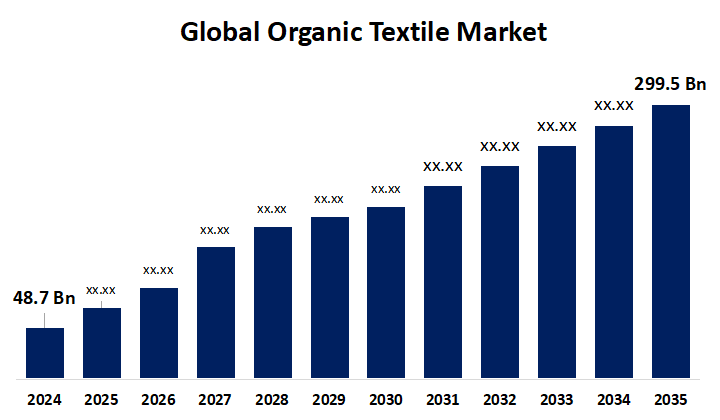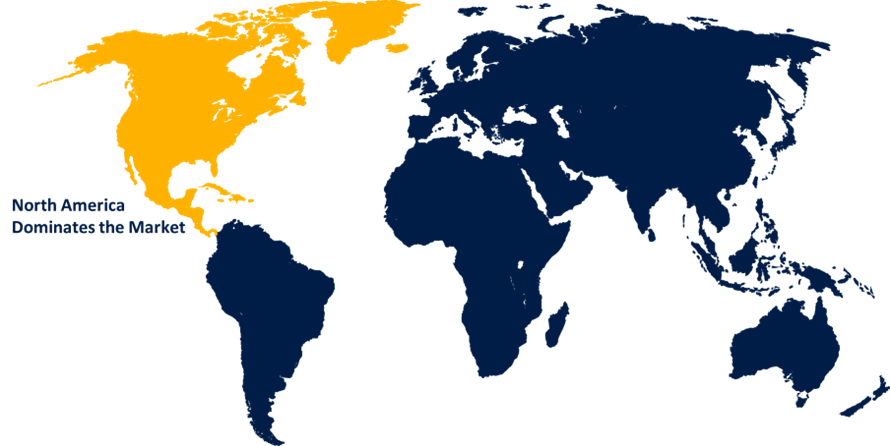Global Organic Textile Market Size, Share, and COVID-19 Impact Analysis, By Fiber Type (Cotton, Linen, Wool, Silk, and Jute), By Product Type (Apparel, Home Textiles, Industrial Textiles, and Medical Textiles), By Certification Standard (Organic Textile Standard (GOTS), Organic Content Standard (OCS), Textile Exchange Organic Cotton Standard (OCS), European Union Organic Textile Standard (EUTS), and National Organic Program (NOP)), By End-Use Application (Fashion, Home Furnishings, Healthcare, and Industrial), and By Region (North America, Europe, Asia-Pacific, Latin America, Middle East, and Africa), Analysis and Forecast 2025 - 2035.
Industry: Chemicals & MaterialsGlobal Organic Textile Market Insights Forecasts to 2035
- The Global Organic Textile Market Size Was Estimated at USD 48.7 Billion in 2024
- The Market Size is Expected to Grow at a CAGR of around 17.95% from 2025 to 2035
- The Worldwide Organic Textile Market Size is Expected to Reach USD 299.5 Billion by 2035
- Asia Pacific is expected to grow the fastest during the forecast period.

Get more details on this report -
The global organic textile market size was worth around USD 48.7 billion in 2024 and is predicted to grow to around USD 299.5 billion by 2035 with a compound annual growth rate (CAGR) of 17.95% from 2025 to 2035. Increasing consumer environmental concerns, along with the rise in eco-friendly fashion and sustainability trends, are driving the organic textile market globally.
Market Overview
The organic textile market is the industry emphasizing the production and sale of textiles made from fibers grown and processed according to organic standards, without harmful pesticides, synthetic fertilizers, or genetic modification. Organic textiles, with their sustainable benefits, aim to counteract the massive negative environmental and social impacts of the global textile sector. The use of organic textiles enables the removal of artificial chemicals used in textile applications. Further, the trend of the sustainable packaging industry for reducing traditional plastic packaging, with an improved and demanding lifestyle of medical personnel, is escalating the organic textile market.
The emergence of luxury fashion houses has made the use of organic fabrics and online platforms available to eco-conscious buyers. Development of novel types of organic fibers, expanding organic farming, and adoption of a circular fashion approach are bolstering the market growth opportunity for organic textile.
Report Coverage
This research report categorizes the organic textile market based on various segments and regions, forecasts revenue growth, and analyzes trends in each submarket. The report analyses the key growth drivers, opportunities, and challenges influencing the organic textile market. Recent market developments and competitive strategies such as expansion, type launch, development, partnership, merger, and acquisition have been included to draw the competitive landscape in the market. The report strategically identifies and profiles the key market players and analyses their core competencies in each sub-segment of the organic textile market.
Global Organic Textile Market Report Coverage
| Report Coverage | Details |
|---|---|
| Base Year: | 2024 |
| Market Size in 2024: | USD 48.7 Billion |
| Forecast Period: | 2025-2035 |
| Forecast Period CAGR 2025-2035 : | 17.95% |
| 2035 Value Projection: | 299.5 Billion |
| Historical Data for: | 2020-2023 |
| No. of Pages: | 225 |
| Tables, Charts & Figures: | 119 |
| Segments covered: | By Fiber Type, By Product Type, By Certification Standard, By End-Use Application, By Region |
| Companies covered:: | Patagonia, Coyuchi, Texollini, Eileen Fisher, Continental Clothing Co., SKNL Basics, Pact, Thought, Fair Indigo, Veja, Organic Basics, Komodo, Synergy Organics, Reformation, Kotn, and Other |
| Pitfalls & Challenges: | COVID-19 Empact, Challenges, Future, Growth, & Analysis |
Get more details on this report -
Driving Factors
An increasing consumer environmental concern encompassing a wide range of issues, including climate change, biodiversity loss, pollution, deforestation, and resource depletion, is contributing to driving the market demand for organic textile. The upsurging fashion trend, along with the emergence of innovative solutions such as eco-friendly dyes and advanced recycling technologies that offer promising avenues for reducing waste and promoting circularity within the fashion ecosystem, is significantly propelling the organic textile market. Additionally, the focus on transparency and traceability in the supply chain for supporting a transition to a low-carbon economy is promoting market growth.
Restraining Factors
An increased price of organic cotton is negatively impacting the market growth of organic textile. Further, the shortage of organic fibers and a lack of consumer awareness about the organic textile benefits are hampering the market.
Market Segmentation
The organic textile market share is classified into fiber type, product type, certification standard, and end-use application.
- The cotton segment dominated the market with the largest share in 2024 and is projected to grow at a substantial CAGR during the forecast period.
Based on the fiber type, the organic textile market is divided into cotton, linen, wool, silk, and jute. Among these, the cotton segment dominated the market with the largest share in 2024 and is projected to grow at a substantial CAGR during the forecast period. This is attributed to the adoption sustainable farming practices, signifying a reduction in water consumption and elimination of chemicals, providing a much more environmentally friendly alternative. An increasing consumer need for sustainable and eco-friendly textiles is contributing to driving the market in the cotton segment.
- The apparel segment accounted for the largest market share in 2024 and is anticipated to grow at a significant CAGR during the forecast period.
Based on the product type, the organic textile market is divided into apparel, home textiles, industrial textiles, and medical textiles. Among these, the apparel segment accounted for the largest market share in 2024 and is anticipated to grow at a significant CAGR during the forecast period. There is an increasing demand for organic clothing, made from natural fibers like organic cotton, wool, and hemp, owing to the driving environmental impact of conventional textile production. Increased commitment to sustainable and eco-friendly fashion, with changing consumer purchasing habits, is driving the market in the apparel segment.
- The organic textile standard (GOTS) segment accounted for the largest market share in 2024 and is anticipated to grow at a significant CAGR during the forecast period.
Based on the certification standard, the organic textile market is divided into organic textile standard (GOTS), organic content standard (OCS), textile exchange organic cotton standard (OCS), European Union organic textile standard (EUTS), and national organic program (NOP). Among these, the organic textile standard (GOTS) segment accounted for the largest market share in 2024 and is anticipated to grow at a significant CAGR during the forecast period. GOTS is the worldwide leading textile processing standard for organic fibers, including Environmental Criteria, backed up by Third Party certification of All Processing Stages. Rigid environmental and social criteria of GOTS are responsible for driving the organic textile market in the organic textile standard (GOTS) segment.
- The fashion segment held the dominant market share in 2024 and is expected to grow at a significant CAGR during the projected period.
Based on the end-use application, the organic textile market is divided into fashion, home furnishings, healthcare, and industrial. Among these, the fashion segment held the dominant market share in 2024 and is expected to grow at a significant CAGR during the projected period. There is an increasing need for eco-friendly and sustainable fashion products. An increasing consumer consciousness about the environmental footprint, which enables the adoption of greener practices by manufacturers and designers, is propelling the market in the fashion segment.
Regional Segment Analysis of the Organic Textile Market
- North America (U.S., Canada, Mexico)
- Europe (Germany, France, U.K., Italy, Spain, Rest of Europe)
- Asia-Pacific (China, Japan, India, Rest of APAC)
- South America (Brazil and the Rest of South America)
- The Middle East and Africa (UAE, South Africa, Rest of MEA)
North America is anticipated to hold the largest share of the organic textile market over the predicted timeframe.

Get more details on this report -
North America is anticipated to hold the largest share of the organic textile market over the predicted timeframe. An increasing demand for textile products for OEMs and protective equipment, along with an increasing consumer awareness of sustainability, is contributing to driving the market. Further, the region’s increased disposable income, sustainability awareness, and stringent regulatory policies are propelling the regional organic textile market.
Asia Pacific is expected to grow at a rapid CAGR in the organic textile market during the forecast period. An increasing industrial shift towards sustainable textile materials and manufacturing practices, along with an increasing need for eco-friendly fibers, including organic cotton, is significantly driving the market. An increasing need for organic goods among consumers, with an increased awareness about climate change and ethical production practices, is propelling the market demand.
Europe is anticipated to hold a substantial market share of the organic textile market during the predicted timeframe. The presence of eco-conscious consumers, along with government initiatives promoting organic textiles, is driving the market for organic textile. Further, the revolutionization of the textile industry decarbonizes and reduces waste through eco-friendly textile-to-textile recycling, contributing to promoting the organic textile market.
Competitive Analysis:
The report offers the appropriate analysis of the key organizations/companies involved within the organic textile market, along with a comparative evaluation primarily based on their type of offering, business overviews, geographic presence, enterprise strategies, segment market share, and SWOT analysis. The report also provides an elaborative analysis focusing on the current news and developments of the companies, which includes type development, innovations, joint ventures, partnerships, mergers & acquisitions, strategic alliances, and others. This allows for the evaluation of the overall competition within the market.
List of Key Companies
- Patagonia
- Coyuchi
- Texollini
- Eileen Fisher
- Continental Clothing Co.
- SKNL Basics
- Pact
- Thought
- Fair Indigo
- Veja
- Organic Basics
- Komodo
- Synergy Organics
- Reformation
- Kotn
- Others
Key Target Audience
- Market Players
- Investors
- End-users
- Government Authorities
- Consulting And Research Firm
- Venture capitalists
- Value-Added Resellers (VARs)
Market Segment
This study forecasts revenue at global, regional, and country levels from 2020 to 2035. Spherical Insights has segmented the organic textile market based on the below-mentioned segments:
Global Organic Textile Market, By Fiber Type
- Cotton
- Linen
- Wool
- Silk
- Jute
Global Organic Textile Market, By Product Type
- Apparel
- Home Textiles
- Industrial Textiles
- Medical Textiles
Global Organic Textile Market, By Certification Standard
- Organic Textile Standard (GOTS)
- Organic Content Standard (OCS)
- Textile Exchange Organic Cotton Standard (OCS)
- European Union Organic Textile Standard (EUTS)
- National Organic Program (NOP)
Global Organic Textile Market, By End-Use Application
- Fashion
- Home Furnishings
- Healthcare
- Industrial
Global Organic Textile Market, By Regional Analysis
- North America
- US
- Canada
- Mexico
- Europe
- Germany
- UK
- France
- Italy
- Spain
- Russia
- Rest of Europe
- Asia Pacific
- China
- Japan
- India
- South Korea
- Australia
- Rest of Asia Pacific
- South America
- Brazil
- Argentina
- Rest of South America
- Middle East & Africa
- UAE
- Saudi Arabia
- Qatar
- South Africa
- Rest of the Middle East & Africa
Need help to buy this report?